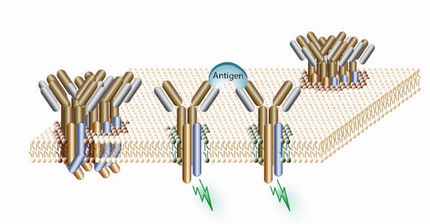Scientists develop new method to investigate origin of life
Scientists at Penn State have developed a new computational method that they say will help them to understand how life began on Earth. The team's method has the potential to trace the evolutionary histories of proteins all the way back to either cells or viruses, thus settling the debate once and for all over which of these life forms came first. "We have just begun to tap the potential power of this method," said Randen Patterson, a Penn State assistant professor of biology and one of the project's leaders. "We believe, if it is possible at all, that it is within our grasp to determine whether viruses evolved from cells or vice-versa." The new computational method will be described in a paper in a future issue of Proceedings of the National Academy of Sciences.
The team is focusing on an ancient group of proteins, called retroelements, which comprise approximately 50 percent of the human genome by weight and are a crucial component in a number of diseases, including AIDS. "Retroelements are an ancient and highly diverse class of proteins; therefore, they provide a rigorous benchmark for us to test our approach. We are happy with the results we derived, even though our method is in an early stage," said Patterson. The team plans to make the algorithms that they used in their method available to others as open-source software that is freely available on the Web.
Scientists map out the evolutionary histories of organisms by comparing their genetic and/or protein sequences. Those organisms that are closely related and share a recent common ancestor have greater degrees of similarity among their sequences. In their paper, the researchers describe how they used 11 groups of the retroelement proteins - ranging from bacteria to human HIV - to trace the evolutionary histories of retroelements. Their method uses a computer algorithm to generate evolutionary profiles - also called phylogenetic profiles - that are compared all-against-all. For example, given four sequences, the new method compares profile A to profiles B, C, and D; it compares profile B to profiles C and D; and so on, for a total of six comparisons. The method then selects the regions of the profiles that match and creates a tree-like diagram, called a phylogenetic tree, based on the retroelements' similarities to one another. The tree provides evolutionary distance estimates and, hence, phylogenetic relationships among retroelements. Patterson said that the results from this study help to clarify many existing theories on retroelement evolution.
The conventional method for estimating evolutionary relationships, called multiple sequence alignment, also produces evolutionary trees, but can be insensitive to relationships among the most distantly related proteins, in large part because it makes only one simultaneous comparison across all of the genetic/protein sequences. To obtain more detailed information about possible relationships among the sequences, a human expert who can manually search for such relationships is needed. But Patterson said that relying on humans to do the work is not ideal.
"Although the human mind is the most powerful tool for pattern recognition, human-based measurements often are hard to reproduce," he said. "For example, if you do something and I do something, we're going to do it differently. It's better to have a standardized method for gauging relationships among ancient proteins, and that's exactly what we've created." According to Damian van Rossum, Penn State research associate/assistant professor of biology and another leader on the project, the new method can be used in conjunction with the conventional method to get a clearer picture of the evolutionary histories of proteins. "The more independent measures you have, the better view of the world you can get," he said.
Other news from the department science
These products might interest you

Limsophy by AAC Infotray
Optimise your laboratory processes with Limsophy LIMS
Seamless integration and process optimisation in laboratory data management

ERP-Software GUS-OS Suite by GUS
Holistic ERP solution for companies in the process industry
Integrate all departments for seamless collaboration

Get the life science industry in your inbox
By submitting this form you agree that LUMITOS AG will send you the newsletter(s) selected above by email. Your data will not be passed on to third parties. Your data will be stored and processed in accordance with our data protection regulations. LUMITOS may contact you by email for the purpose of advertising or market and opinion surveys. You can revoke your consent at any time without giving reasons to LUMITOS AG, Ernst-Augustin-Str. 2, 12489 Berlin, Germany or by e-mail at revoke@lumitos.com with effect for the future. In addition, each email contains a link to unsubscribe from the corresponding newsletter.


















































